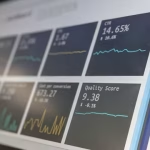At Novatia Consulting, we understand that Process Mapping and Documentation in Nigeria are crucial for enhancing efficiency in the country's dynamic business environment. By strategically analyzing workflows, we pinpoint bottlenecks and redundancies, fostering clarity and improved collaboration among teams. Effective documentation not only standardizes practices but also ensures regulatory compliance and informed decision-making, ultimately positioning organizations as leaders in their industries. Our dedication to continuous improvement involves utilizing advanced mapping tools and encouraging stakeholder involvement. As we delve into the intricacies of these practices, we will reveal how Process Mapping and Documentation in Nigeria can drive operational excellence and elevate your organization's performance.
Key Takeaways
- Enhancing Efficiency through Process Mapping and Documentation in Nigeria: Process mapping optimizes workflows in Nigeria, enhancing efficiency and identifying bottlenecks within organizational processes.
- The Importance of Effective Documentation for Regulatory Compliance in Nigeria: Effective documentation promotes clarity and consistency, vital for regulatory compliance and stakeholder communication in Nigerian organizations.
- Simplifying Complex Processes: The Role of Visual Representation in Process Mapping and Documentation in Nigeria: Utilizing visual representation techniques like flowcharts can simplify complex processes and improve understanding among team members.
- Fostering Collaboration in Process Mapping and Documentation in Nigeria: Engaging stakeholders through open communication and feedback mechanisms fosters collaboration and ensures successful implementation of process improvements.
- Empowering Organizations in Nigeria through Continuous Improvement Strategies in Process Mapping and Documentation: Continuous improvement strategies, such as Lean and Six Sigma, empower organizations in Nigeria to systematically enhance operational efficiency and effectiveness.
Understanding Process Mapping
Understanding Process Mapping for Enhanced Organizational Efficiency
Understanding process mapping is essential for optimizing organizational workflows and improving efficiency. By delving into process analysis, we can identify areas where bottlenecks occur, redundancies exist, or resources are underutilized. Together, we can visualize our processes, making them easier to understand, communicate, and enhance.
Engaging in process mapping involves more than just creating visual representations; it requires a strategic analysis of our workflows to identify inefficiencies. Each step in a process can be scrutinized for its value, allowing us to streamline operations. As we evaluate each component, we can question its necessity and explore avenues to eliminate non-value-adding activities. This thorough examination sets the stage for effective workflow optimization.
Furthermore, process mapping promotes collaboration among team members. When we collectively illustrate our workflows, everyone gains clarity regarding their roles and responsibilities. This transparency enhances communication and aligns our efforts toward shared goals. It also enables us to monitor progress and make necessary adjustments, ensuring we remain agile in a dynamic environment.
It is important to recognize that process mapping is not a one-time initiative. It is an ongoing practice that necessitates regular updates and reassessment. As our organization evolves, so must our workflows. By continuously revisiting our process maps, we can foster a culture of continuous improvement, ultimately driving greater efficiency and effectiveness.
Importance of Documentation
While we often focus on the intricacies of process mapping, the importance of documentation cannot be overstated. Effective documentation serves as the backbone of any successful process, providing clarity and consistency across teams. It allows us to standardize practices, ensuring that everyone is on the same page and can easily access essential information when needed.
However, we face various documentation challenges that can hinder our efforts. Inadequate adherence to documentation standards can lead to inconsistencies, making it difficult to replicate successful processes. Additionally, the absence of a centralized repository can create silos of information, where vital knowledge is lost or inaccessible. This not only slows down operations but also increases the risk of errors, as team members may rely on outdated or incomplete information.
To tackle these documentation challenges, we must prioritize the establishment of robust documentation standards that promote clarity, accuracy, and accessibility. By developing thorough templates and guidelines, we can streamline our documentation processes, ensuring that every team member understands their role in maintaining accurate records. Furthermore, investing in training and resources will enable our teams to adopt these documentation standards effectively.
In essence, by recognizing the importance of documentation and addressing the associated challenges, we can improve our process mapping initiatives. This strategic approach will not only enhance operational efficiency but also foster a culture of continuous improvement, where learning and adaptation become integral to our organizational success.
Key Benefits in Nigeria
In Nigeria, the key benefits of effective process mapping and documentation are becoming increasingly apparent across various sectors. By delving deeper into these advantages, we uncover how they significantly enhance operational efficiency and promote a culture of continuous improvement. One of the most prominent benefits is regulatory compliance. As the Nigerian business landscape becomes more regulated, organizations that implement process mapping can navigate the complexities of compliance requirements more effectively. By meticulously documenting processes, we not only streamline adherence to regulations but also reduce the risk of penalties and legal complications.
Additionally, stakeholder participation is greatly improved when processes are well-documented. With a clear understanding of their roles and responsibilities, all involved parties can communicate more efficiently. This clarity fosters trust among stakeholders, as they can easily monitor progress and comprehend how their contributions align with organizational objectives. Effective stakeholder involvement leads to more informed decision-making, ensuring that all parties are aligned and engaged.
Moreover, effective process mapping enables us to pinpoint inefficiencies and bottlenecks within our operations. By analyzing these areas, we can implement targeted improvements that minimize waste and boost productivity. This strategic approach not only enhances our bottom line but also establishes us as leaders in our respective industries.
Common Process Mapping Tools
Clarity in Process Mapping Tools: Essential for Optimizing Operations
In the pursuit of optimizing operations, clarity in process mapping is paramount for organizations. Utilizing various process mapping tools can significantly enhance this clarity. When we refer to common process mapping tools, we highlight options that not only improve our ability to visualize processes effectively but also help in strategically selecting the right tool tailored to our specific needs.
Microsoft Visio stands out as one of the most popular process mapping tools, offering a comprehensive array of templates and shapes that facilitate detailed process visualization. Its user-friendly drag-and-drop interface provides extensive mapping capabilities, making it accessible for users of all skill levels. For teams looking for a cloud-based process mapping solution, Lucidchart is an excellent alternative. This tool enables real-time collaboration, allowing multiple stakeholders to seamlessly contribute to the mapping process.
Another noteworthy process mapping tool is Bizagi, which excels in supporting process modeling and automation. Bizagi not only enables visualization but also simulates processes, providing deeper insights into potential bottlenecks. Additionally, tools like ProcessMaker and ARIS offer robust features for mapping complex workflows, ensuring compliance and governance needs are met.
When considering the selection of a process mapping tool, it is crucial to evaluate factors such as ease of use, integration capabilities, and scalability. The unique requirements of each organization will dictate which process mapping tool aligns best with their objectives. Ultimately, choosing the right tool can significantly enhance process mapping efforts, resulting in improved efficiency and productivity.
Steps in Process Mapping
Mapping a process involves a series of strategic steps that enhance our ability to visualize and understand workflows effectively. To kick off, the first step is process identification. In this phase, we clearly define the specific process we intend to map. It's essential to gather input from stakeholders to ensure we encompass all facets of the process, from initiation to completion.
Once the process is identified, we progress to workflow analysis. This critical step entails breaking down each element of the process, scrutinizing how tasks are executed, and recognizing dependencies between tasks. It is important to document who is accountable for each step, the resources needed, and the expected outcomes. This comprehensive analysis enables us to identify inefficiencies or bottlenecks that may hinder progress.
The next step involves creating a visual representation of the workflow. By employing flowcharts or diagrams, we can outline the steps in an easily digestible format. It is crucial to ensure that the visual map accurately reflects the tasks discussed and their interrelationships.
Following the creation of the initial map, we should validate it with stakeholders. This step ensures that our representation aligns with their experiences and expectations. Any discrepancies should be addressed and adjusted accordingly to enhance accuracy and effectiveness.
Best Practices for Documentation
Having established a clear process map, we now need to focus on documentation to confirm our workflows are effectively communicated and maintained. Effective documentation is a cornerstone of operational excellence, so let's consider some best practices that we can implement.
First, we should adopt standardized documentation techniques. By creating templates for different types of documents, we confirm consistency across our organization. This consistency not only improves clarity but also makes it easier for team members to locate necessary information. Next, let's establish documentation standards. These standards should outline the required elements and formats for every document, including headings, fonts, and terminology. This approach minimizes confusion and fosters a professional appearance.
Furthermore, we must prioritize accessibility in our documentation. Our documents should be easily accessible to all relevant stakeholders. This may involve utilizing a centralized digital repository where documents can be quickly retrieved and updated. We should also encourage regular reviews and updates of our documentation to keep it current and relevant. This practice not only maintains accuracy but also confirms compliance with evolving organizational standards.
Visual Representation Techniques
As we advance, it is essential to delve into visual representation techniques that enhance our comprehension of processes. These techniques allow us to distill complex workflows into simpler forms and improve clarity through effective graphical representation. By leveraging mapping software, we can generate intricate diagrams that conform to established diagram standards, ensuring consistency and precision.
Among the prevalent methods is the flowchart technique, which utilizes visual symbols to illustrate various steps within a process. By incorporating notation systems, we can standardize our flowcharts, making them universally interpretable. This not only facilitates workflow analysis but also enhances communication among team members.
Additionally, data visualization is crucial to our strategy. By converting raw data into visual formats, we uncover insights that might otherwise be hidden. This approach encourages collaborative mapping, enabling stakeholders to engage in real-time discussions, refine process flows, and pinpoint areas for enhancement.
In our strategic initiatives, we must prioritize the development of intuitive diagrams that enable quick understanding. Whether through traditional flowcharts or more sophisticated techniques, our objective remains constant: to enhance our grasp of processes and promote efficiency. By harnessing these visual representation techniques, we equip ourselves with the necessary tools to navigate and optimize our operations effectively. This is vital for achieving clarity and fostering continuous improvement in our organizational processes.
Aligning Processes With Goals
Aligning Processes with Organizational Goals for Enhanced Efficiency
The coordination of processes with organizational goals is vital for driving success and fostering efficiency. When we synchronize our processes with clear objectives, we create a framework that not only improves productivity but also ensures that every team member understands their role in the bigger picture. This alignment of goals and processes is significant, as it transforms strategic visions into actionable steps, enabling us to measure our progress effectively.
To achieve this alignment, we need to establish performance metrics that accurately reflect our organizational goals. By identifying key performance indicators (KPIs) that resonate with our objectives, we can monitor our processes in real-time, making adjustments as necessary to stay on track. These metrics serve as a roadmap, guiding our teams toward desired outcomes while highlighting areas for improvement.
Additionally, we should regularly review our processes to confirm they remain in sync with evolving goals. The business landscape is dynamic, and our strategies must adapt accordingly. Through continuous process mapping and documentation, we can visualize how our workflows contribute to our overarching aims, making it easier to identify gaps and redundancies.
Engaging Stakeholders Effectively
Engaging Stakeholders Effectively: A Pathway to Enhanced Collaboration
Coordinating our processes with organizational goals sets the stage for engaging stakeholders effectively. By synchronizing our objectives, we can foster a culture of collaboration that improves stakeholder participation. It's crucial to identify who our stakeholders are and understand their interests and concerns. This understanding allows us to tailor our communication strategies, ensuring that we address their needs while keeping them informed throughout the process.
We should prioritize open lines of communication, establishing regular updates and feedback mechanisms. This not only builds trust but also encourages stakeholders to actively participate in discussions. Utilizing various communication platforms—be it meetings, emails, or digital forums—can help us reach diverse stakeholder groups effectively. By employing these strategies, we can facilitate a two-way dialogue that invites input and fosters ownership.
Moreover, we need to be strategic about the timing and frequency of our communications. Involving stakeholders at critical junctures in our process mapping allows us to gather valuable insights and adjust our strategies as necessary. We can also employ visual aids or process maps to clarify complex information, making it easier for stakeholders to grasp and contribute.
Ultimately, engaging stakeholders effectively requires a commitment to transparency and responsiveness. By actively involving stakeholders in our process mapping and documentation efforts, we not only improve their satisfaction but also enhance the overall quality and effectiveness of our processes. Together, we can create a collaborative environment that drives our organizational goals forward.
Challenges in Process Mapping
Navigating the Challenges of Process Mapping: Stakeholder Involvement and Technology Integration
Steering through the complexities of process mapping presents several challenges that can hinder our progress. One of the primary obstacles we face is guaranteeing effective stakeholder involvement. It's essential that we identify all relevant stakeholders early on, but often, their participation can be inconsistent. Without their insights and commitment, we risk missing significant elements that could lead to incomplete or inaccurate process maps. We must be strategic in our approach to keep stakeholders informed and involved throughout the mapping process.
Another significant challenge lies in technology integration within process mapping. As we adopt various tools for process mapping, we must ensure they align with our existing systems and workflows. This can be particularly intimidating, especially in environments where technology usage is inconsistent or where team members vary in their tech-savviness. If we fail to provide adequate training or support, we might encounter resistance, leading to underutilization of valuable mapping tools.
Moreover, the rapid pace of technological advancement in the realm of process mapping means we need to stay updated on the latest innovations in software. This requires us to be proactive, investing time in researching and evaluating new options that could enhance our mapping efforts.
Case Studies in Nigeria
Examining Case Studies in Nigeria: Insights into Process Mapping Applications
The exploration of case studies in Nigeria offers valuable insights into the practical applications of process mapping across various sectors. As we delve into case study analysis, it becomes evident how local businesses have effectively utilized process mapping to streamline operations, enhance efficiency, and ultimately foster growth.
In a noteworthy case, a Nigerian manufacturing firm employed process mapping to uncover bottlenecks within its production line. By visually documenting each stage of the process, the company was able to identify delays and redundancies. This led to targeted interventions, such as reallocating resources and refining workflows, resulting in a marked reduction in both production time and costs.
Another compelling example arises from the financial sector, where a local bank embraced process mapping to enhance customer service. By mapping the customer journey, they identified pain points in the account opening process. Equipped with this information, the bank reengineered its procedures, significantly reducing turnaround time and elevating customer satisfaction scores.
These case studies highlight the strategic significance of process mapping for local businesses in Nigeria. By adopting this methodology, companies can achieve a clearer understanding of their operations, facilitating informed decision-making and sustainable improvements. Furthermore, the successful outcomes demonstrated in these case studies serve as a blueprint for other organizations seeking to optimize their processes. As we reflect on these examples, it is clear that process mapping transcends being merely a theoretical exercise; it is a practical tool for attaining operational excellence within the Nigerian context.
Measuring Process Efficiency
Measuring Process Efficiency: A Key to Operational Excellence
Measuring process efficiency is vital for organizations aiming to enhance their operational performance. By systematically evaluating our processes, we can pinpoint bottlenecks, redundancies, and areas that present opportunities for improvement. Establishing clear efficiency metrics that align with our organizational goals is essential. These metrics provide quantitative data that enables us to effectively assess process performance.
To begin, we should define key performance indicators (KPIs) tailored to our processes. Metrics such as cycle time, throughput, and resource utilization are critical in this regard. By collecting and analyzing this data, we can uncover insights into how well our processes are functioning and identify where enhancements are necessary.
Furthermore, it is important to regularly review these efficiency metrics. This ongoing assessment ensures we remain agile and can adapt our strategies based on real-time data. It also fosters accountability among teams, as they can observe how their contributions affect overall process efficiency.
Incorporating performance comparison practices can further enhance our understanding of process efficiency. By benchmarking our performance against industry standards or competitors, we can identify gaps and establish realistic improvement targets.
Continuous Improvement Strategies
To drive meaningful change, we need to embrace continuous improvement strategies that cultivate a culture of ongoing development within our organization. Continuous improvement is not merely a buzzword; it is a fundamental approach that shapes our decision-making processes and enhances our operational efficiency. By implementing structured methodologies, such as Lean and Six Sigma, we can systematically identify inefficiencies and initiate targeted improvements.
In our quest for process optimization, we should prioritize data-driven analysis. This entails regularly evaluating our processes, gathering insights from team members, and utilizing metrics to assess our performance. Through techniques like root cause analysis, we can uncover the underlying issues impacting our processes. This empowers us to develop actionable strategies that not only address current deficiencies but also mitigate future challenges.
Furthermore, establishing a feedback loop is crucial. We should promote open communication among teams and actively solicit their perspectives on process obstacles. This collaborative approach fosters a sense of ownership and ensures that our continuous improvement initiatives are well-informed and comprehensive.
Training and Development Needs
Identifying Training and Development Needs for a Dynamic Workforce
Identifying training and development needs is essential to ensure that our team is well-prepared to tackle the challenges of a rapidly changing work environment. To effectively achieve this, we must conduct comprehensive skill evaluations to identify the specific competencies that require enhancement. This strategic approach allows us to customize our training methods, ensuring alignment with our learning objectives.
In our commitment to professional development, we should emphasize capacity building initiatives that promote both individual and team growth. By recognizing our diverse learning styles, we can implement targeted training programs that resonate with each team member, facilitating optimal knowledge transfer. This tailored approach not only enhances engagement but also fosters better retention of information.
Furthermore, cultivating a culture of collaboration during training sessions is crucial. By encouraging open communication and the sharing of experiences, we create an environment where collective problem-solving flourishes. This synergy not only reinforces the training content but also strengthens our team dynamics, ultimately enhancing overall performance.
As we navigate the complexities of process mapping and documentation in Nigeria, our dedication to ongoing training and development will be a significant differentiator. By routinely assessing our development needs and adjusting our strategies accordingly, we will ensure that our team remains agile and responsive to industry demands. This proactive approach not only elevates our team's morale but also positions us as leaders in our field, ready to address any challenges that may arise.
Future Trends in Process Mapping
As we prioritize training and development, it's essential to explore how process mapping is evolving to meet the demands of modern organizations. The landscape is shifting rapidly due to digital transformation, necessitating an adaptation of our strategies to maintain relevance. One significant trend in process mapping is the rise of automation, which streamlines repetitive tasks and enhances efficiency. By incorporating automation into our process mapping efforts, we can redirect our focus towards more strategic initiatives that drive innovation.
Agile methodologies are also increasingly influential in process mapping. By adopting agile principles, we can develop flexible frameworks that quickly respond to shifting market conditions. This adaptability is further enhanced by collaborative tools that support real-time communication among team members, regardless of their physical location.
Data analytics plays a crucial role in optimizing process mapping. By harnessing data insights, we can pinpoint bottlenecks, enhance user experiences, and make informed decisions that lead to process innovation. Moreover, the integration of AI offers predictive capabilities, enabling us to anticipate challenges and seize opportunities.
Remote mapping has become a necessity in our digitally-driven world. Leveraging cloud solutions allows us to collaborate seamlessly across geographical boundaries, ensuring that all stakeholders have access to the most up-to-date process documentation.
Frequently Asked Questions
What Industries in Nigeria Benefit Most From Process Mapping?
When examining the industries in Nigeria that benefit most from process mapping, several key sectors emerge. In the manufacturing industry, process mapping significantly enhances efficiency, resulting in reduced waste and increased output. In the healthcare sector, the optimization of processes through mapping leads to improved patient care and better resource management. The agriculture industry also experiences productivity gains by streamlining operations, allowing for more effective use of resources.
In the banking and finance sectors, financial transparency is greatly enhanced by well-mapped processes, fostering trust and accountability. Meanwhile, the telecommunications industry thrives on innovation driven by well-defined process mapping, which supports the rapid deployment of new services. Each sector's strategic application of process mapping not only drives performance but also fuels growth, making it an indispensable tool for success in Nigeria's diverse economic landscape.
How Long Does Process Mapping Typically Take to Implement?
When evaluating the timeline for implementing process mapping, it's important to recognize that the duration can vary significantly based on the complexity of the organization and the specific mapping techniques employed. Typically, the implementation period can range from a few weeks to several months. To ensure a successful execution, it is crucial to thoroughly assess our current processes to accurately define the scope and identify the necessary resources. This comprehensive evaluation will enable us to streamline the process and achieve effective implementation that aligns with our strategic goals.
Who Should Be Involved in the Process Mapping Process?
When it comes to process mapping, we recognize that stakeholder involvement is crucial. Engaging team members from a variety of departments allows us to gain insights from different perspectives, enriching the mapping process. Furthermore, including leadership ensures alignment with strategic goals, fostering a cohesive approach. By employing diverse mapping techniques, we can capture a comprehensive view of our processes. Through collaboration, we will identify inefficiencies and uncover improvement opportunities, ultimately creating a more effective and streamlined workflow that benefits all stakeholders involved.
What Are the Costs Associated With Process Mapping in Nigeria?
When analyzing the costs associated with process mapping in Nigeria, it is essential to conduct a comprehensive cost analysis. Budget considerations play a crucial role, as we must account for various elements such as tools, training, and the investment of time. The costs can fluctuate significantly based on the complexity of the processes involved. By strategically planning our budget, we can ensure that we are making informed investments in process mapping. This, in turn, will lead to enhanced efficiency and effectiveness in our operations.
Can Process Mapping Improve Customer Satisfaction in Businesses?
Absolutely, process mapping can significantly enhance customer satisfaction in businesses. By visualizing the customer journey, we can pinpoint bottlenecks and optimize operations for improved process efficiency. This clarity enables us to customize experiences and respond to customer needs more effectively. When we align our processes with customer expectations, we not only elevate satisfaction but also cultivate loyalty, paving the way for long-term success. It's a strategic method that yields substantial benefits in customer relationships.







